Can a deer really "duck" your arrow? Here's an illustrated guide to shot placement on moving white-tailed deer.
Running deer are my absolute favorite thing to draw and paint. A graceful high jumper, explosive sprinter and fierce competitor, the white-tailed buck is a natural born athlete. His agility and athleticism are rivaled only by his durability, toughness and cunning. As an artist, it’s an absolute privilege to depict such an animal.
As a bowhunter though, moving deer present a challenge. In my studio, I can freeze a buck in time and give myself hours, days and even weeks to study and paint him in the pose that I choose. In the deer stand though, all I can do is give him a hoarse "meh" with my mouth and stop him for a couple seconds, and rarely in the perfect position for a shot.
To help my fellow bowhunters in our shared predicament, here’s a collection of art and information showing whitetails in motion from my popular print, The Anatomy & Physiology of the White-tailed Buck. I spent months researching and drawing the anatomy of white-tailed deer, with the help and advice of expert biologists and hunters from across North America.

CAN DEER REALLY “DUCK” AN ARROW?
A spooked deer will drop, loading up its back legs to bound away. Bowhunters know this as “ducking the arrow.” But it’s really not ducking at all, it’s simply gravity pulling the deer downward when it lifts it’s legs to bound away.
An alert buck would seem to have an advantage here, as common sense would tell you his alerted state would result in lightning-fast reaction time. But the amount of movement it takes to drop his head and neck to bound away takes valuable time.
A feeding buck (still highly alert) already has his head and neck low. When he snaps his neck upward, this acts like fulcrum, pulling his body downward further and faster than gravity alone could if he was standing upright.

CONSIDER THE ANGLES ON QUARTERING AWAY SHOTS
As a deer turns and the angle of the shot increases, the gap between individual ribs closes down, creating a shield of bone. For example, take your hand, hold it away from you and spread your fingers apart. Now turn your hand 90 degrees, keeping your fingers spread apart, and watch the gaps between your fingers narrow.
While the ribs on a deer are not particularly heavy, this wall of bone can still deflect an arrow. Keep this in mind on hard quartering away shots. In these instances, it’s best to try and slip an arrow in behind the last rib than aim too far forward and risk a glancing blow off the ribcage.

SHOULD I SHOOT AT A WALKING DEER?
If possible, wait until the leg closest to you is in the most forward position to shoot. The leg joint will be clear of the heart and lower lungs and the buck’s massive shoulder muscles will be stretched thinly across his ribcage, rather than in a tightly flexed mass in front of his vitals.
This is easier said than done on a cruising buck with his mind set on a doe, and nearly impossible to time. Feeding deer, however, will almost always give you this shot if you're patient.

As an artist, it’s my passion to enhance the atmosphere of deer camp. The best way I know to do that is through my best-selling paper prints “The Growth & Maturity of the White-tailed Buck" and “The Anatomy & Physiology of the White-tailed Buck.” The above art and information (plus much, much more) can be found in one place that you can hang on the wall. It’s been an honor to produce them, and I guarantee you they’ll be the talk of hunt camp!
Wishing you a successful deer season,



